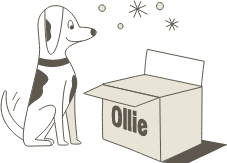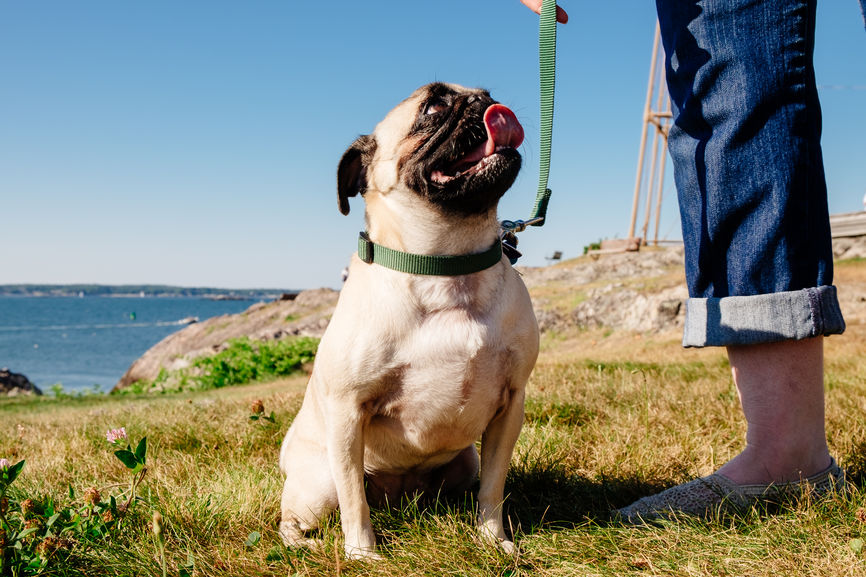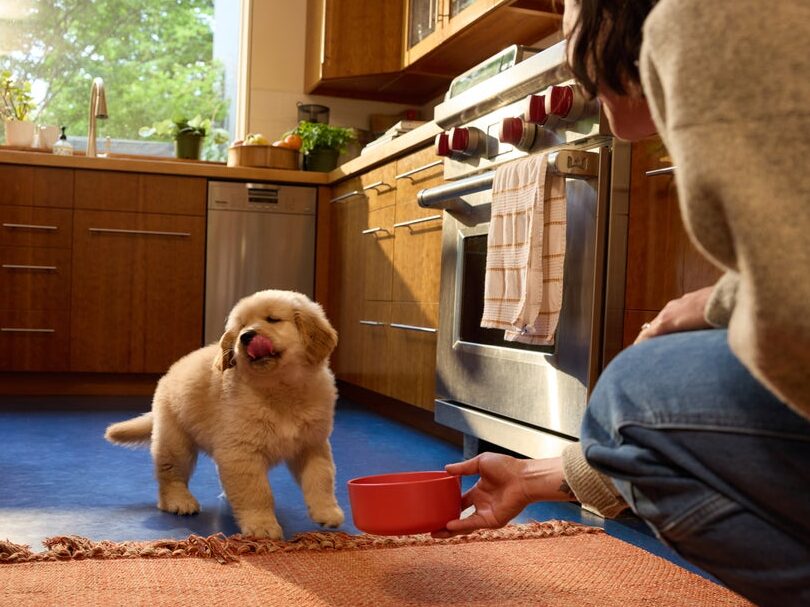Hey Ollie blog readers! We’re offering you an exclusive 60% OFF your starter box! Try now!
E-collars for dogs are a divisive issue in the dog training world. While some trainers are strictly against using e-collars for dogs, others rely on them to provide clear and immediate feedback. Amid this contentious issue lies the question: Are e-collars safe for dogs? To learn the answer, we asked two professional trainers for their perspectives, as well as what owners should consider before using this popular training tool.
What Is a dog E-Collar?
An e-collar for dogs is an electronic training aid. Sometimes known as a remote training collar or zap collar, an e-collar consists of a wireless remote a pet parent or trainer carries and a wireless receiver that a dog wears on a close-fitting collar. E-collars are used to teach dogs the difference between good and bad behavior by sending feedback (i.e., physical signals) through the collar.
How Do E-Collars for Dogs Work?
E-collars for dogs transmit electric stimulation, which you may have experienced during a chiropractic or physical therapy session. The electric stimulation is not a shock, but more of a pulsing wave sensation. The handler controls an e-collar’s electric stimulation intensity, which can range from low to high. The intensity can be adjusted based on a dog’s temperament and the training goal.
Some e-collars also have vibration settings, which are recommended for sensitive or soft dogs. When a pet parent or trainer uses these settings, the dog experiences a vibration stimulus rather than an electric impulse. In addition, some e-collars include a GPS tracker, so you can monitor your dog and their movement.
Given their functional abilities, how are e-collars used in dog training? “E-collars work as a form of negative reinforcement, meaning that a behavior is strengthened by removing a negative outcome,” says Blake Rodriguez, dog behavior expert and owner of Dream Come True K9. For example, if you’re driving in your car without a seatbelt, that annoying dinging sound that stops when you buckle up is a form of negative reinforcement. “The dinging stops when you perform the desired behavior. And that’s exactly how e-collars function.”
Dog Collar vs. Dog Harness: Which is Better for Training?
Potential Safety Risks of Dog E-Collars
In the American Veterinary Society of Animal Behavior (AVSAB) position statement on The Use of Punishment for Behavior Modification in Animals, the organization does not condone using punishment and aversive tools, including electronic, choke, and pinch collars, as first-line training options for addressing dog behavior. The organization’s concerns include not only the dog’s physical safety but also their emotional and psychological wellbeing. Consider dog e-collar potential safety risks:
- Decreased or delayed learning — Punishment-based training can cause a dog confusion, frustration, and anxiety, and can in turn inhibit learning, especially if a dog isn’t simultaneously shown how to receive reinforcement by performing the correct behavior.
- Increased risk for physical harm to pets and people — Pain, discomfort, and frustration caused by ineffective e-collar training can trigger fear-based reactions such as bites or attacks. Without a balanced training plan, e-collar training may only suppress—not eliminate—aggressive behavior, potentially leading to injuries, and increased stress and internal conflict for the pet.
- Heightened fear and anxiety — Punishment-based methods can erode a dog’s confidence, create distrust, and increase nervous behavior. Anxiety may become generalized, causing the dog to experience a continuous emotional state of apprehension and distress.
- Habituation to pain — Some dogs can adapt or tolerate certain pain levels, requiring the owner to regularly increase the aversive stimulus intensity, resulting in more significant discomfort, pain, and potential stress for the dog.
Pros of E-Collars for Dogs
Despite the debate, Rodriguez argues that when used appropriately, e-collars are an effective and safe training tool. He explains that an e-collar is just another way to communicate with your dog, and basically an extension of the leash. However, he warns that a trainer should never use an e-collar as a last resort or a shortcut. “Think about the e-collar as a way to take the language of right and wrong to the next level. If your dog is pulling, leash pressure might be fine,” explains Rodriguez. “But if your dog starts to run toward the street, a higher-level correction is necessary for the dog’s safety.”
According to e-collar users, another advantage is the training tool’s ability to improve the trainer’s timing when delivering a correction. Many times, correcting your dog the moment they act out is not feasible, but such delays—even as brief as a few seconds—can negatively affect your dog’s understanding. According to Rodriguez, an e-collar’s nearly instantaneous feedback is especially advantageous for off-leash training, when you may be hundreds of yards away from your dog. In addition, if your dog is in danger, the immediate communication an e-collar provides can literally be the difference between life and death.
If e-collars are a training tool you want to consider, Rodriguez recommends working with a professional trainer. You must fully understand how and when e-collar use is appropriate. If misused, an e-collar can cause far more behavioral problems than it solves.
Why Your Pup is Barking and What You Can Do About It
Cons of E-Collars for Dogs
In the past, e-collars were referred to as shock collars. However, as pet parents grew wary of this harsh punishment, e-collar companies adapted their marketing to soften the training tool’s image. “It’s interesting how we use e-collar as a euphemism for a shock collar because it sounds less harsh. But they’re essentially the same thing,” says Scott Sheaffer, CBCC-KA, CDBC, CPDT-KA, a dog behavior specialist and founder of USA Dog Behavior Specialists. “The collar is designed to have your dog make negative associations with undesirable behaviors. So if the dog does the right thing, they get a treat, and if they do the wrong thing, they receive a shock.”
5 Fun & Essential Cues to Teach Your Pup
According to Sheaffer, the problem with this training method is that the definition of wrong behavior is literally infinite. If you’re using an e-collar to try to train a dog to lay down, they will perform countless wrong behaviors before they achieve the desired result. This process can confuse and frustrate a dog, and the shock only increases their anxiety, says Sheaffer.
Sheaffer claims another issue with the e-collar is that dogs don’t always make the desired associations between their behavior and the electronic stimulus (i.e., stim) or correction. “What I see a lot is inexperienced people using e-collars and punishing the dog with them,” he explains. For example, a dog who receives an e-collar stim for counter surfing might start to associate the pain not with the act itself, but simply with being in the kitchen. Worse, they may associate the pain and surprise with their pet parent’s presence. When a dog associates pain with people, it can heighten their stress levels, which may lead to aggression. “I’ve treated so many cases where I’ve had to work with a dog who has been trained using an e-collar and had so much anxiety associated with a behavior that was completely unrelated to the problem behavior,” says Sheaffer.
How to Stop a Dog From Jumping
That being said, Sheaffer says e-collar training can be effective in a life and death situation. Owners with large properties who allow their dogs to work or play off leash may want to consider working with a professional trainer to teach their dog appropriate boundaries and how to avoid poisonous snakes. For scenarios that are not life-threatening, which includes the majority of training, Sheaffer recommends training your dog using positive reinforcement, so when your dog performs the desired behavior, they get rewarded. If your dog is exhibiting problem behaviors, Sheaffer believes you can address them using other safe and effective methods. We recommend consulting an experienced dog training professional before attempting to handle problematic behavior on your own.
How to Train Your Dog Safely Using an E-Collar
As with any tool that has the potential to cause discomfort or pain inadvertently, you must use an e-collar responsibly, after receiving guidance from a professional trainer. We highly recommend working in-person with an experienced, knowledgeable trainer before using an e-collar on your dog. To use an e-collar responsibly on your dog, follow these key principles:
- Conditioning your dog to the collar — Work with a trainer to ensure appropriate fit, then allow your dog to wear the e-collar so they can acclimate to the feel and weight. Do not simply apply the collar and start correcting your dog.
- Assessing the behavior and making a plan — First, determine the behavior for which you’re using the e-collar and ensure you can’t address the target behavior through another training method (e.g., reward-based or positive reinforcement training), management (e.g., closing the gate, putting your shoes in a closet, or keeping your dog on leash), or a less aversive tool such as a head collar or front clip harness.
- Giving your dog the chance to be right — If you’re training a new behavior, first teach your dog the cue using praise or treats. This helps build the dog’s confidence and allows them to learn the meaning of your verbal cue. When you add the e-collar, always prompt your dog with the cue first and give them several seconds to perform the behavior before applying a correction.
- Using the lowest stimulus setting — Always use the minimum settings necessary to elicit a response from your dog. If you routinely need a greater stimulus, reevaluate your early training. Consider whether your dog may be confused, frustrated, or worried, and is therefore unable to perform the task.
- Applying one correction — Although some trainers employ continuous stimulation, this can be overwhelming for a dog who is new to e-collar training, and applying continuous stimulation can jeopardize the bond you have with your dog. If you’re a novice e-collar user, use single stimulus corrections.
- Remaining emotionally neutral — Emotions and ego have no place in dog training. If you find yourself becoming upset or angry, calmly end the training session. After a break, reevaluate your training strategy, and consider consulting a dog training professional.
- Rewarding your dog for the appropriate response — Ensure to always reward your dog with praise, play, or a treat when they demonstrate the appropriate behavior. Ollie training treats are the perfect size and flavor to reinforce your dog’s effort, reward their accuracy, and accelerate their learning. Plus, the wholesome ingredients mean you can feel good about treating your dog often!
- Keeping training sessions short — A lengthy training session can be stressful and mentally taxing for your dog. If your dog is new to training, limit your sessions to five minutes or fewer. Gradually increase the training session duration if your dog is keen to work, but try not to train longer than 20 minutes.


Healthier ingredients,
tailored recipes, delivered
Get 50% of your first box of Ollie’s fresh
delivered meals today!
The Ollie blog is devoted to helping pet parents lead healthier lives with their pups. If you want to learn more about our fresh, human-grade food, check out MyOllie.com.
Tagged As:

The nutrition your dog needs,
the food they want.

Enjoying our articles? Subscribe our Newsletters and get new articles directly to your inbox
You might also like
13 May 2025
8 MINS READ
Puppy Training Guide & Behavior Timeline
Bringing home a puppy is pure magic. It’s also pure chaos—tiny teeth, zoomies, accidents in the house, and moments that make you wonder if you’re raising a future genius or a tiny tornado. …
by Ollie Pets
10 May 2025
12 MINS READ
New Puppy Checklist: Guide To Prepare For A New Dog
Bringing home a new puppy? This checklist covers everything new dog owners need—from essential supplies to training, feeding, and first vet visits.
by Ollie Pets
3 April 2025
9 MINS READ
Home Remedies for Fleas on Dogs: 10 Natural Ways That Actually Work
Wondering what kills fleas on dogs instantly and naturally? If your pup is scratching like crazy, it may be time to take action. In this guide, we’ll show you the most effective home remedies for…







